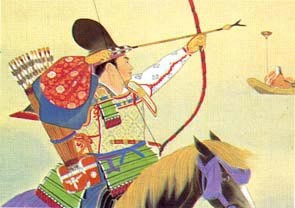|
Japanese
What is the first thing that springs to mind
when you hear the word, “archer”? Is it a hunting man in a cave painting in
Spain? Is it Robin Hood in Lincoln green with a
bow and arrow in Sherwood Forest? Or perhaps is it a man on horseback galloping
over the Mongolian prairie? Anyway, each of them holds his bow almost
in the middle and never draws it further
back than his cheekbone.
The most distinctive differences between
them and Japanese archers is that Japanese
archers use exceptionally tall bows,
usually
over two meters long; they hold their
bows
about one third of the way from the
bottom,
and they draw the bow so that the drawing
hand ends up past their heads. Because of this, the stance of the archer
at the moment when the bow is fully
drawn
looks wide and open, and is said to
be the
most beautiful archery style.
The sound of a bowstring was thought to drive
evil spirits away and so there were
many
ritual events involving bows and arrows
at
Court. From the twelfth century riding a horse and
practicing kyudo, the way of the bow, was an indispensable
martial art for samurai warriors, even
after
the introduction of guns. The bows
and arrows
were made of bamboo and so every samurai’s
house, however small, had bamboo bushes
in
the garden.
There is a famous story about a skilled archer
in Japan. It is a part of “The Tale of the Heike”,
which deals with the struggle for power
at
the end of the twelfth century between
two
strong families, the Heike and the
Genji. The Heike worshipped the gods of Miyajima and donated much treasure to the shrine.
The following episode occurred just
before
the disastrous defeat, the fall of
the Heike,
on the Seto Inland Sea around the city of Takamatsu.
The forces of the two clans were facing each
other. The Heike on the sea and the Genji on the seashore. At dusk, in the twilight, a small decorated
boat approached from the sea. On the
boat
a beautiful woman in colorful, formal
kimono
stood with a rising sun folding fan
at the
top of a pole. This was a challenge
from
the Heike to the Genji. The Commander-in-chief of the Genji ordered Nasu Yoichi to shoot the fan off the pole.
Yoichi was twenty years old and was known
as an excellent archer, but the target now
was quite far away and moving up and down
on the waves caused by the strong north wind.
The samurai warriors of both sides were watching
him wondering if he could do what he had
been ordered to do. Yoichi finally decided
to go into the water on his horse with his
bow and a turnip-headed arrow in his hands.
He prayed with his eyes closed to his tutelary
deity for success. When he opened his eyes,
the wind had dropped. He at once released
the arrow, which made a whirring sound because
of its shape, and successfully hit the fan
a few centimeters from its pivot. The fan
with its rising sun pattern flew up into
the sky and then fell into the sea. On seeing
this, the people both on the sea and on the
shore were moved to praise Yoichi.
After the battles, the Heike went to ruin.
Yoichi was said to have been given
five manors
around the country as a reward for
his meritorious
deed.
When you visit a Japanese archery dojo, you can see many people in kimono and hakama practicing. In winter you can see a number
of young women in their best kimono
release
arrows at Sanju-sangen-do in Kyoto. Yabusame (a type of Japanese archery) archers shoot
a special turnip-headed arrow at a
wooden
target whilst riding a horse, just
like Yoichi.
They can be seen at the Tsurugaoka Hachiman shrine in Kamakura. At the end of sumo tournaments, a sumo
wrestler is chosen to perform a ritual
using
a bow in the sumo ring.
 |
